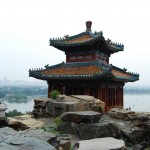Summer Imperial Palace in Beijing and Empress Cixi
The Summer Imperial Palace is one of the most outstanding imperial gardens in China. It is located to the north-west of Beijing, about 20 kilometers from its center. The area of the park complex covers 290 hectares, ¾ of which is water. The park served as the residence and the garden for the Emperors of China while the lake played an important role in supplying Beijing with water and serving as transportation means between the city and its suburbs. People say that once visiting it, you have visited all the beautiful places in China.
The Summer Palace – is a wonderful specimen of the classical Oriental art of landscape architecture. Its big size, architectural splendor, masterful design and natural beauty you can never find elsewhere in the world. Here the man-made beauty and the beauty of nature are presented as one whole.
Here is some information about the names. Although this place is named in all tourist guides as the Summer Imperial Palace, in Chinese (as well as in English spelling) the same guides call it Yiheyuan (Garden of Peace and Harmony). Do not be embarrassed by the confusion in names.
The history of the Summer Palace is more than 800 years long. In 1153, when Jin dynasty moved the capital to Beijing (in those times Yanjing), the imperial palace – Golden Hill Palace – was built on the site of the present Summer Palace. In 1750 Emperor Qianlong spent 4.48 million taels of silver (140000 kg.) and 15 years to build the Garden of Clear Ripples (Qingyiyuan).
This garden unites into one the following five gardens and three hills in the north-eastern section of Beijing: Xiangshan – the Fragrant Hill, Yuquanshan – the Jade Spring Hill, Yuanmingyuan – the Hill of Longevity and the Garden of Perfection and Enlightenment, Changchunyuan – the Garden of Cheerful Spring, Qingyiyuan – the Garden of Clear Ripples, Jingyiyuan – the Garden of Serenity and Delight, and Jingmingyuan – the Garden of Serenity and Brightness.
In 1860 during the Second Opium War allied British and French forces seized Beijing and destroyed the garden. In 1886 the government of Qing Dynasty started rebuilding the garden for Empress Cixi, which took 10 years and 30 million taels of silver (937500 kg.), originally designated for the Chinese navy. Two years later it was renamed into the Garden of Peace and Harmony, but it was better known under the name of Summer Imperial Palace.
Empress Cixi (1835-1908), who was at the time of her birth called Little Orchid (Yehe Nala), was born in a family of a Manchu official. She received good education. From her early years she was determined to join herself to somebody who was higher in social standing to bring fame to her family and spend her life in glory and prosperity.
The Manchu government at that time introduced a system of choosing beautiful girls among the daughters of Manchu officials to make them concubines of the Emperor or wives of the members of the Imperial Clan. In 1851, when Yehe Nala was 16, she was chosen with other 28 girls for the Emperor Xianfeng. Now she was a concubine of the fifth rank. Later by her intriguing and bribing eunuchs and court officials she was able to win the favor of the Emperor of Qing Dynasty.
In 1854 she was granted the status of a Consort. In 1856 she gave birth to a son, who was named Zaichun, who later became the Emperor Tongzhi. As the saying goes, “the mother’s glory is in her son”, so in 1857 Cixi received the status of the Noble Consort — the third highest title after the Empress and the Noble Empress Consort. After her son was enthroned to become the Emperor Tongzhi, she was titled the Divine Mother Empress Dowager.
Emperor Xianfeng had a legitimate wife Empress Ci′an. She and Cixi became known as the East Empress Dowager and the West Empress Dowager. When the Xianfeng Emperor died in 1861 at the mountainous resort Chengde, Cixi and Ci′an organized a coup to set up the system of ruling the country from “behind the curtains”. For the next 48 years she was reigning over China and virtually became the last de-facto ruler of the Qing Dynasty.
In 1875, when the Tongzhi Emperor died of sickness (apparently syphilis), Cixi chose the four year old Zaitian, prince Yihuan’s son (who was married to her sister), as the heir of the throne. Thus she was able to stay at power. The four year old Zaitan later became the Guangxu Emperor. In 1881 Ci′an, the East Empress Dowager, suddenly died (many believe that she was poisoned by Cixi). In 1884 Cixi demoted prince Gong who helped her in the coup, stripping him of all important offices, and appointed prince Yixuan instead.

